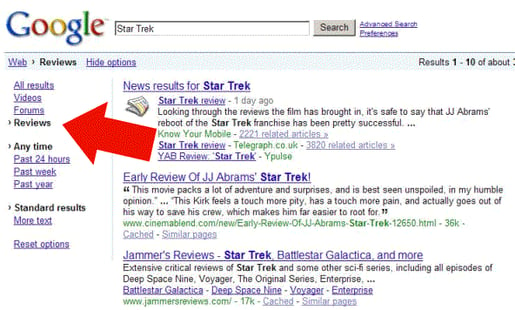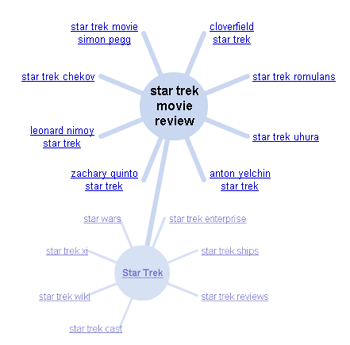More Major Google Changes; Search Options Surface

Very rarely are there seismic shifts in the search landscape. For the past several years, search engines have only teased us with universal/blended search and dangled in front of us the promise that open standards (RDFa and microformats) would bring a new era of search. This morning was the first true sign that universal or blended search is real and that adding another layer of data will indeed result in a better experience for everyone - consumers and Web professionals.
Announced at its Searchology event, Google is showing the Web that it can not only straight index and rank Web pages, it can also categorize and extract information and present that data in some truly fascinating ways. Take that Wolfram-Alpha. First, the "Show Options" feature (which enables users to modify the presentation of organic/natural results) is going to level the playing field for Web professionals.
Say a user wants to search for a Star Trek movie review.

The "Show Options" feature opens a new sidebar on the SERPs (see below) that gives users the ability to restrict search results to video, forums, reviews or recent pages. What Google has done is to let users obtain results from various types of content already indexed by Google and modify (through restrictions) what content is presented.
Perhaps the most important, and the feature that supports what was mentioned yesterday on Website Magazine (in Mike Phillips' post on User Reviews Invading Google SERPs), is the ability to restrict results to reviews only. Using what seems to be sentiment analysis, Google is allowing users to see a snippet of exactly what the review's author has to say about the query being searched for. How do they do that? Keep reading...

A few other features include the presence of an extended list of related searches with the Wonder Wheel (a visualization feature that lets users improve their query by trying different suggestions successively - see below) and a timeline (users can explore how search topics change over time, as the 'timeline options' groups results by dates referred to on the actual pages - drilling down the results to a year or a month, for example).
Wonder Wheel:

Timeline:

So how does this affect Web professionals whose traffic relies on SEO?
My assumption is that it will matter quite a bit, but in a good way. Below are a few techniques (which hopefully will come as no surprise) that you should adopt if you have not already.
- Produce content on a regular basis (daily if necessary) to provide exposure when consumers leverage time restrictions on search results (take that Twitter!)
- Look closer at long-tail keywords (both for SEO and SEM optimization) through both related searches feature and the Wonder Wheel
- Consider adding video to your marketing mix, as well as increasing participation in forums
- Focus on managing your brand at review sites (identify those sites by using the new features)
- Develop (or rework) existing pages with rich snippets (see below as this is very important)
Underlying many of the new features is Google's new focus on and support of microformats to create "rich snippets" which use meta data from Web pages (such as hCard, hCalendar) to display additional details (both content and meaning) about pages in the results. This highly structured data - which is embedded in Web pages - is really only open to a few larger portals like Yelp and LinkedIn now, but Google will be indexing this data from more sites over time. Google doesn't guarantee that the presence of this metadata will result in rich snippets, but you can request consideration via a form. If Google finds this metadata during regular crawls, it may use it in rich snippets; the form isn't a prerequisite, but may get the content indexed more quickly.
This means that you should be taking steps to display rich snippets by including markup formats like microformats and RDFa, and do that as soon as possible. By creating standard annotations, you make structured data available for Google and any service or tool that supports the same standard (like Yahoo! Search Monkey). The data that you will ultimately be encoding within a microformat structure might include the writer of the review, the date the review was written, the rating, or for items with multiple reviews, the number of reviews and average rating. For more information on Microformats, visit Microformats.org or see Google's documentation about marking up structured data.
While it's up in the air whether or not consumers will actually leverage this function with any regularity, it should be noted that, at any time, Google could move from presenting this information upon request to presenting it by default. Should that happen, you'll be prepared by taking the important steps outlined above.








